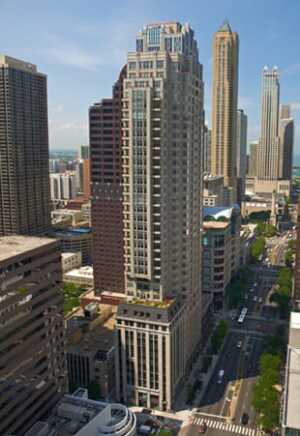Condominium development is back in Chicago, starting off smaller—but often grander—than before the recession that slowed construction to a crawl for nearly a decade.
At the current stage of the latest condo construction cycle, projects are much smaller, typically featuring fewer than 100 units. Yet the size of the individual units, along with their price tags, has swelled in 2015 and 2016.
And that is unlikely to change anytime soon, according to a ULI Chicago panel discussion held September 22 at the Union League Club of Chicago.
“The days [when] we could build a two-bedroom, two-bath condominium unit of 1,100 to 1,200 square feet [102 to 111 sq m] and sell [units] for $300,000 are gone,” residential developer Alan Lev, president and CEO of Belgravia Group, said during the event. “It’s not going to be back. A two-bedroom unit, if you’re lucky, is in the high fours. And this is not downtown. This is out in the neighborhoods.”
Lev was one of three Chicago-based panelists at the event, titled “Chicago’s Condo Awakening—New Developments in For-Sale Housing.” He was joined on the panel by fellow developer James Letchinger, president and founder of JDL Development, and Michael Golden, cofounder of residential brokerage @properties. The panel discussion was moderated by Gail Lissner, vice president of Chicago-based Appraisal Research Counselors.
The panelists point to several factors likely to continue steering new projects toward lower unit counts and higher prices for the foreseeable future.
With the condo crash still fresh in their minds, lenders and investment partners are reluctant to finance huge developments that take several years to complete, leaving them vulnerable to another real estate downturn. Meanwhile, higher land values—driven up in part by a soaring apartment rental market—and construction costs and the city’s new affordable housing requirements for new projects have pushed developers toward the high end of the for-sale market in order to offset rising development costs.
“It’s almost impossible to build a large-scale, entry-level building largely because of the cap rates and the value on the rental side—and, partially, purely on the construction cost side,” Golden said.
For labor and materials, “I think it’s the toughest market I’ve seen going back to ’05–06, when it was really kind of insane,” Letchinger said.
Higher prices mean that many potential condo buyers, who once bought a one- or two-bedroom unit as their first home, are on the sidelines or in the resale market, Golden said.
“There’s a lot of talk about millennials and how they’re waiting [to buy homes],” Golden said. “They are coming out of their parents’ basements. They’re in the rental market, but they’re definitely wanting to buy. The biggest problem that we have is just the total lack of supply for them.”
Announced new condo units in the works in downtown Chicago totaled fewer than 100 in 2011, 2012, and 2013, according to Appraisal Research Counselors. Though still modest, the total topped 300 in 2014, more than 500 in 2015, and more than 300 thus far in 2016. Most of 2015’s total is 400 units that were announced in Vista Tower, a 93-story condo and hotel tower that Chinese developer Dalian Wanda Group and Chicago’s Magellan Development Group recently broke ground on in the Lakeshore East area of downtown.
In the Gold Coast neighborhood, where Letchinger’s firm is building the 70-unit No. 9 Walton luxury tower, the average condo from 2004 to 2014 measured 2,873 square feet (267 sq m), according to Appraisal Research Counselors. In 2015 and thus far in 2016, it is 3,700 square feet (344 sq m). In the Loop and River North areas, the average unit size has nearly doubled, to about 2,500 square feet (232 sq m).
That trend is the opposite of downtown Chicago’s apartment market, where units have been shrinking, Lissner noted.
Despite averaging almost 4,500 square feet (418 sq m) and $5.5 million per sale, No. 9 Walton is already about 90 percent presold more than a year before the project’s scheduled completion, Letchinger said.
“We felt that the top of the market was underserved,” Letchinger said. “The question [was], are people not buying $4 [million] and $5 million units because they can’t afford them or because they don’t exist?”
Earlier this year, JDL also bought 153 unsold units in the Walton on the Park development next door to No. 9 Walton. The units have been rentals since sales stalled in the 201-unit project, which was completed in 2009.
JDL has changed the property’s name to 2 W. Delaware, its address, and plans to combine many one- and two-bedroom condos into larger units while adding new amenities, Letchinger said. The bulk deal allows JDL to offer more units in the Gold Coast area, where demand is high, with a faster turnaround and lower cost than a ground-up development, he said.
“There’s a need for product in that location,” he said. “It’s very hard to build in this area. If you try to do a new project in the Gold Coast area, you’re going to have to be in for well over $1,000 a foot. That does price many people out.”
Even so, in the infancy of this condo cycle many developers are willing to pay up for the certainty of top downtown and North Side locations.
“We’re staying in the same neighborhoods” in planning new projects, said Lev, whose firm is working on projects in Lincoln Park, River North, and the West Loop. “We’re not pioneering. I’d rather overpay or pay up for a really good site than buy a less expensive piece of land where I’m not sure people would want to live there.”
Ryan Ori covers commercial real estate for Crain’s Chicago Business.







